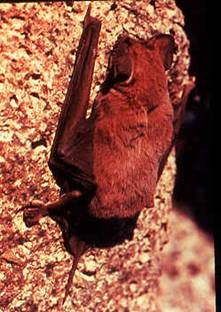Field Guide/Mammals/Eastern Red Bat
< Field Guide | Mammals
| Lasiurus Borealis (Eastern Red Bat) | |
|---|---|
|
Family: Bat (Vespertilionidae)
Size: The average length of the Eastern Red Bat is 4.28in (108.9mm). The average length of it's tail: 2.07in (52.7mm). It's average weight: .4 ounces.[1]
Description: The Eastern Red Bat is moderately sized with long, pointed wings. It has small feet with ears that are low, broad, and rounded. Its fur is a rusty red with tints of light brown and white.[2]
Similar Species: The feature that will distinguish the Eastern Red Bat from any other species is their hair color. The rusty red tint is unlike any other fur color from the bat family.[3]
Range: The Eastern Red Bat's population is all over North and South America. In Minnesota, this bat can be seen in all parts of the state.[1]
Habitat: Their habitats tend to be heavily human populated areas with trends of urban areas. Their habitats can be trees, shrubbery, and sometimes near the ground.[4]
Diet: This species dines on moths and beetles.[2]
Activity: Eastern Red Bats are nocturnal and thrive at night. It spends most of the day sleeping. This species migrates south for the winter in late summer.[3]
Reproduction: Mating takes place in flight and copulation occurs in August or September. Female Red Bats give birth to twins each year. Their young learn to fly at about 5 weeks old and it takes them about another 5 weeks to learn to fly on their own.[4]
Lifespan: The Eastern Red Bat's lifespan is about 12 years of age.[2]
Notes: The Eastern Red Bat is known as one of the most beautiful bats in all of North America. Its red color and piercing eyes make it stand out from the rest. This species is on the “least concerned” list when it comes to extinction because of its wide distribution, large population, and habitat tolerance. They prefer to live in trees and hang there to sleep during the day and live/hunt at night. They have been recorded in existence since the mid 1800’s. This bat does not form large colonies and is a very independent species.
|
 |
- ↑ a b Shump, Karl (1982), Lasiurus Borealis, The American Society of Mammalogists, pp. 1–6
- ↑ a b c Arroyo-Cabrales, Jay; Reid, F (2008), Lasiurus Borealis, IUCN Red List of Threatned Species, p. 1
- ↑ a b Davis, Andrew (2010), Pelage color of red bats lasirrus borealis varies with body size, Journal of Zoology, pp. 401–405
- ↑ a b Kurta, Allen (2010), Reproductive timing, distribution and sex ratios of tree bats in lower Michigan, Journal of Mammalogy, pp. 586–592